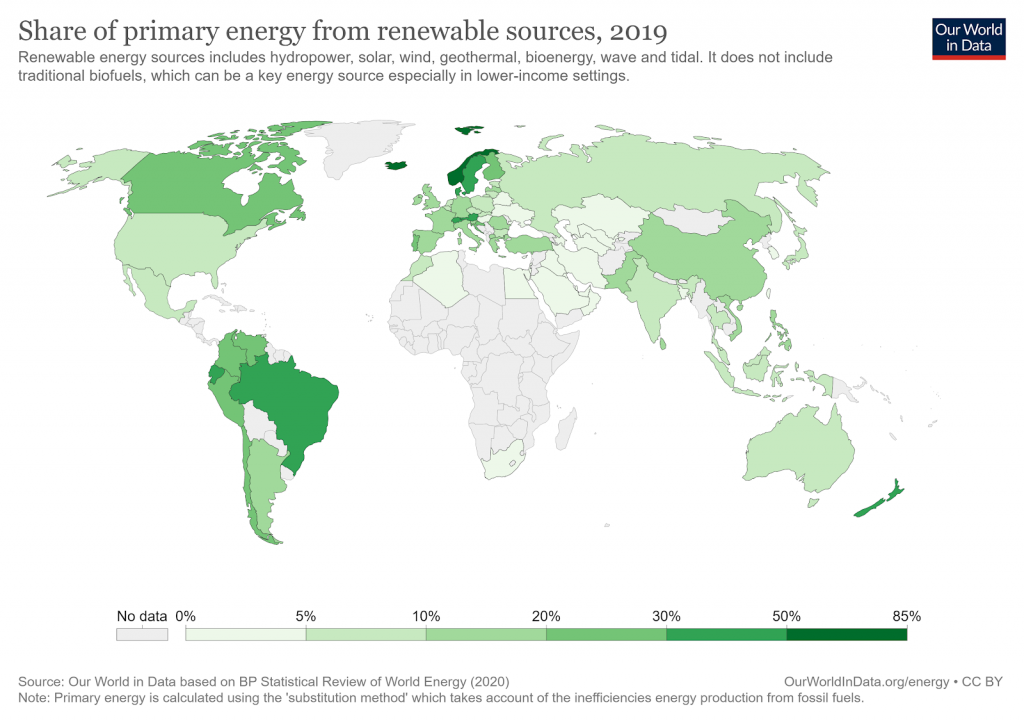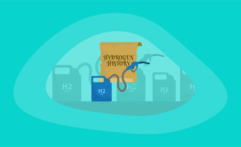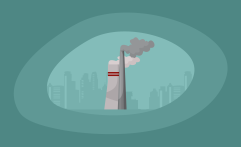Sustainable Energy vs Alternative Energy: What’s the Difference?
Impactful Ninja is reader-supported. When you buy through links on our site, we may earn an affiliate commission.
Learn more
Learn more
.
Hey fellow impactful ninja ? You may have noticed that Impactful Ninja is all about providing helpful information to make a positive impact on the world and society. And that we love to link back to where we found all the information for each of our posts. Most of these links are informational-based for you to check out their primary sources with one click. But some of these links are so-called "affiliate links" to products that we recommend. First and foremost, because we believe that they add value to you. For example, when we wrote a post about the environmental impact of long showers, we came across an EPA recommendation to use WaterSense showerheads. So we linked to where you can find them. Or, for many of our posts, we also link to our favorite books on that topic so that you can get a much more holistic overview than one single blog post could provide. And when there is an affiliate program for these products, we sign up for it. For example, as Amazon Associates, we earn from qualifying purchases. First, and most importantly, we still only recommend products that we believe add value for you. When you buy something through one of our affiliate links, we may earn a small commission - but at no additional costs to you. And when you buy something through a link that is not an affiliate link, we won’t receive any commission but we’ll still be happy to have helped you. When we find products that we believe add value to you and the seller has an affiliate program, we sign up for it. When you buy something through one of our affiliate links, we may earn a small commission (at no extra costs to you). And at this point in time, all money is reinvested in sharing the most helpful content with you. This includes all operating costs for running this site and the content creation itself. You may have noticed by the way Impactful Ninja is operated that money is not the driving factor behind it. It is a passion project of mine and I love to share helpful information with you to make a positive impact on the world and society. However, it's a project in that I invest a lot of time and also quite some money. Eventually, my dream is to one day turn this passion project into my full-time job and provide even more helpful information. But that's still a long time to go. Stay impactful,Affiliate Disclosure
Why do we add these product links?
What do these affiliate links mean for you?
What do these affiliate links mean for us?
What does this mean for me personally?
![]()
When discussing fossil fuel replacement energies, “sustainable” and “alternative” are commonly used synonymously. But there are situations where the two are not mutually exclusive. And recognizing these differences is key to making informed decisions about energy sources. So we had to ask: What’s the difference between sustainable and alternative energy?
Sustainable energy is the generation of energy from sources that are replenished faster than they are depleted. Alternative energy does not produce greenhouse gas emissions or harm the environment. Knowing the differences between the two aids in the fight against global climate change.
So, how can we tell the difference between sustainable and alternative energy? Can an energy source be categorized as one but not the other? What are the benefits and drawbacks of each? Find out the answers to all of these questions below, and see what this means as we strive for a more sustainable future.
How Are Sustainable Energy and Alternative Energy Defined
“Sustainable” and “alternative” energy are not synonyms, despite commonly being referred to as so. They both aim to reduce global greenhouse gas (GHG) emissions and mitigate climate change, but the differences in their definitions have different implications on our environment.
What Does the Dictionary Say About Sustainable Energy and Alternative Energy
Sustainable and alternative energy sources are alternatives to fossil fuels and aid in the fight against global climate change because they help curtail GHGs. Knowing the difference between the two terms allows us to make better-informed decisions regarding our energy usage.
Sustainable energy sources meet the needs of our current generation without compromising the ability of future generations to meet their own needs. They aim to limit GHG emissions while preserving the natural integrity of the environment.
“Sustainable: The ability to be maintained at a certain rate or level | Avoidance of the depletion of natural resources in order to maintain an ecological balance”
Oxford Dictionary
Alternative energy is an energy substitute for fossil fuels (e.g., coal, oil, natural gas) that can reduce the effects of global warming. It does not produce GHG emissions or negatively impact the environment, making it both sustainable and environmentally friendly.
“Alternative Energy: electricity or power that is produced from the sun, wind, water, etc. in ways that do not use up the earth’s natural resources or harm the environment”
Oxford Dictionary
Alternative energy does not produce GHG emissions, is non-polluting, and does not harm the environment. But it may have intermittent energy production, geographic limitations, and nuclear waste byproducts.
What Do These Differences Mean
The differences in the definitions of sustainable energy and alternative energy have different implications on our environment:
- If energy is only sustainable but NOT alternative: The rate of resource harvest is less than the rate of natural resource replenishment, but the generation of energy harms the environment.
- If energy is only alternative but NOT sustainable: The generation of energy does not harm the environment, but the rate of resource harvest is greater than the rate of natural resource replenishment.
In short, sustainable energy means the rate of resource utilization is less than the rate of natural resource replenishment. Alternative energy sources do not harm the environment.
What Are the Differences and Similarities Between Sustainable Energy and Alternative Energy
When discussing our present and future energy usage it is important to understand to which category each of the following energy types belongs. Using energy sources that meet both the “sustainable” and “alternative” criteria can help reduce the amount of GHGs entering the atmosphere and preserve the natural state of the environment.
| Energy type | Energy source |
| Both Sustainable Energy and Alternative Energy | Solar, Wind, Geothermal, Micro/Low Hydropower, Wave |
| Only Sustainable Energy but not Alternative Energy | Tidal |
| Only Alternative Energy but not Sustainable Energy | Nuclear |
| Renewable energy that is neither Sustainable nor Alternative | Biomass, Large Hydropower |
Some energies can be classified as both sustainable and alternative, some only fit into one category, and others don’t fit into either category. After researching the rate of resource utilization and the energy’s impact on the environment, we can effectively categorize the following nine energy sources as either sustainable and alternative, only one of the two, or neither.
Which Energies are Both Sustainable Energy and Alternative Energy
If energy is both sustainable AND alternative the rate of resource harvest is less than the rate of natural resource replenishment, and the generation of energy does not harm the environment.
Here are the energy sources that are both sustainable AND alternative:
“Solar Energy: energy that uses the power of the sun to produce electricity”
Cambridge Dictionary
- Solar energy: The conversion of sunlight into electrical energy either through the use of photovoltaic (PV) panels or solar radiation concentrating mirrors. The energy produced is then used to generate electricity or can be stored in batteries or thermal storage for use at a later time. The three main types of PV solar cells are silicon, thin-film, and III-V solar cells. The three main types of concentrating solar thermal power plants are linear, dish/engine, and power tower systems.
Solar energy is sustainable and alternative because it produces minimal GHGs and does not negatively affect the environment, provided that proper siting and disposal methods are followed.
“Wind: a current of air moving approximately horizontally, especially one strong enough to be felt”
Cambridge Dictionary
- Wind Energy: Wind turns turbine blades around a rotor, which spins a generator to create electricity. An average annual wind speed of 9 miles per hour (mph) or 4 meters per second (m/s) for small turbines and 13mph (5.8m/s) for utility-scale turbines is necessary to economically harness wind energy. The two main types of wind energy are onshore wind energy and offshore wind energy. The former has lower construction, transportation, maintenance cost, and infrastructure needed to transmit electricity than the latter. The two types of wind turbines are Horizontal Axis Wind Turbine (HAWT) and Vertical Axis Wind Turbine (VAWT). The largest commercial turbines consist of 780 foot (240 m) tall towers and 530 foot (162 m) long blades that can generate anywhere from 4.8 to 9.5 MW of power.
Wind energy is sustainable and alternative because it does not emit greenhouse gases and land use, wildlife impact, and public health concerns are mitigated by proper planning and siting of wind farms.
“Geothermal: involving or produced by the heat that is inside the earth”
Cambridge Dictionary
- Geothermal Energy: The decay of radioactive materials in the rock and fluid of the earth’s core produces geothermal energy. Drilling down to hot water reservoirs up to a mile below the surface creates steam that rotates a turbine, which spins a generator to generate electricity. Geothermal is found along major tectonic plate boundaries where volcanoes are located. The three main types of geothermal power plants are dry steam, flash steam, and binary steam.
Geothermal energy is sustainable because it produces low levels of GHGs and does not negatively affect the environment.
“Hydropower: hydroelectric power (= the production of electricity by the force of fast-moving water)”
Cambridge Dictionary
- Hydropower Energy: To harness energy from water, flowing water turns turbines and spins a generator to generate electricity. Micro hydropower generates 100 kilowatts (kW) or less of power, and low-impact hydropower (Low Hydro) generates between 100 kW and 10 MW.
Low hydropower is sustainable because it produces fewer GHGs than large hydro and has a minute environmental impact.
“Wave Power: electrical energy generated by harnessing the up-and-down motion of ocean waves”
Britannica
- Wave Energy: Waves are formed when the wind blows over the surface of the water on oceans or lakes. 95% of the wave’s energy is stored between the surface of the water and the top 1/4th of the wave’s length. The three types of wave energy technology are float/buoy, oscillating water column, and tapered channel systems. They use the rise and fall of waves to produce electricity.
Wave energy is believed to be sustainable and alternative because as long as the sun shines, waves are produced and can be used to generate power.
Which Energies Are Only Sustainable Energy But Not Alternative Energy
If energy is ONLY sustainable but NOT alternative the rate of resource harvest is less than the rate of natural resource replenishment, but the generation of energy harms the environment.
Here are the energy sources that are ONLY sustainable:
“Tidal Power: power that comes from the movement of the tide (= the rise and fall of the ocean that happens twice every day) and that can be used especially for producing electricity”
Cambridge Dictionary
- Tidal Energy: The gravitational pull of the sun and moon coupled with the rotation of the earth creates tides in the ocean. A minimum tidal range of 10 feet is required to harness tidal energy economically. The three types of tidal energy technology are stream, barrage, and lagoon systems which use the rise and fall of tides to spin a generator to produce electricity
For tidal energy, lagoons are the most sustainable form of tidal energy, followed by tidal streams and lastly by barrages. The main environmental concern with tidal and wave energy is the impact on aquatic wildlife. Construction and operation of marine energy technology may negatively impact estuarine ecosystems via underwater noise pollution, habitat changes, and wildlife collisions with turbines. Because tidal and wave energy is a relatively new technology, more research needs to be done to fully understand this environmental impact.
Which Energies Are Only Alternative Energy But Not Sustainable Energy
If energy is ONLY alternative but NOT sustainable the generation of energy does not harm the environment, but the rate of resource harvest is greater than the rate of natural resource replenishment.
Here are the energy sources that are ONLY alternative:
“Nuclear Power: the power produced when the nucleus (= central part) of an atom is divided or joined to another nucleus”
Cambridge Dictionary
- Nuclear Energy: The two ways to generate nuclear power are nuclear fusion and nuclear fission. In the former, atoms are combined or fused to create larger atoms. In the latter, electromagnetic radiation is used to split the nucleus of a uranium atom, which releases an enormous amount of energy.
Nuclear energy is not sustainable because nuclear power plants use the second most common isotope of Uranium (U-235) which has a relative abundance of only 0.7%. Most of the original U-235 on earth has already decayed because it has a half-life of about 700 million years.
Nuclear energy has a minimal land use impact and produces few waste products. Nuclear energy produces more electricity on less land than any other clean-air source. A standard, 1,000-megawatt facility located in the US requires a little more than 1 square mile to operate, a number that is 360 and 75 times less than what is required for wind farms and solar plants, respectively. Also, all of the used nuclear fuel that the US produced in the past 60 years could fit onto a football field at a depth of fewer than 10 yards. There are no other byproducts.
The main concern associated with nuclear energy is nuclear waste. Although nuclear power produces minimal waste, the waste that it does produce is radioactive and can remain hazardous for many thousands of years. These radioactive waste products include uranium mill tailings, spent (used) reactor fuel, and other radioactive wastes. If these were to leach into the environment it could contaminate the soil and water. Ways to minimize negative environmental impacts include the proper handling, transportation, storage, and disposal of radioactive waste to ensure that it does not leach into the environment.
Which Renewable Energies Are Neither Sustainable Energy Nor Alternative Energy
If energy is NEITHER sustainable NOR alternative, either the rate of resource harvest is greater than the rate of natural resource replenishment, the generation of energy harms the environment, or both.
Here are the energy sources that are NEITHER sustainable NOR alternative:
“Biomass: natural materials from living or recently dead plants, trees and animals, used as fuel and in industrial production, especially in the generation of electricity”
Oxford Dictionary
- Biomass Energy: Biomass is renewable organic material that comes from plants and animals. It is incredibly versatile and can be used to produce fuel, energy, and everyday products that contain plastics. To harvest biomass energy, wood, agricultural crops, biogenic materials, animal manure, and human sewage are burned or are converted to release stored chemical energy from the sun. Biomass can be used to produce biofuels, biopower, and bioproducts.
Biomass energy is not sustainable because the rate of plant harvest often exceeds the rate of plant growth. It could take anywhere from decades to well over a century before we start receiving the climate benefits provided by biomass, which is well outside the timeframe of averting our current climate crisis. Also, per kWh, biomass power plants emit 150% the carbon dioxide (CO2) of coal and between 300% – 400% the CO2 of natural gas, making them a major contributor to climate change.
Biomass is also not alternative because a major environmental drawback is deforestation, which occurs at roughly 10 million hectares (~ 25 million acres) per year. Trees combat climate change, purify the air, provide housing for millions of plant and animal species, protect against floods and water pollution, and improve mental health. Chopping trees to produce wood pellets that are then burned for electricity has a devastating effect on the environment because it reduces the amount of trees that can capture our CO2 emissions.
“Hydropower: hydroelectric power (= the production of electricity by the force of fast-moving water)”
Cambridge Dictionary
- Hydropower Energy: To harness energy from water, flowing water turns turbines and spins a generator to generate electricity. Large hydropower (Large Hydro) generates 30 MW or more of power.
Large hydro is not sustainable or alternative because it can alter the natural state of the environment via interfering with fish migration, blocking aquatic movement up/downstream, and altering temperature and dissolved oxygen concentration. Also, Vegetation inundation and decomposition in hydropower reservoirs can release GHG emissions in the form of both CO2 and CH4. CH4 has a global warming potential 28-34 times that of CO2 and can make up 80% of the emissions from dam reservoirs, as a study from Washington State University found.
Why Is it Important to Differentiate Difference Between Sustainable Energy and Alternative Energy
| Sustainable Energy | Alternative Energy | |
| Benefits | Limited GHG emissions, non-polluting, climate mitigation benefits, preservation of natural resources | Limited GHG emissions, non-polluting, does not harm the environment |
| Drawbacks | – | Some have intermittent production, geographic limitations, or nuclear waste byproducts |
Sustainable energy aims to limit GHG emissions while preserving the natural integrity of the environment. An energy source can be sustainable as long as the rate of resource harvest stays below the rate of natural resource replenishment. Harvesting, utilizing, operating, and building infrastructure are all areas where the energies could become unsustainable.
Alternative energy does not produce greenhouse gases or negatively impact the environment, making it a good alternative to fossil fuels. On the other hand, it can have intermittent production and geographic limitations. The disposal of nuclear waste and containment of radioactive material are other issues that need to be addressed when considering implementing this energy source.
How Do Sustainable Energy and Alternative Energy Benefit the Environment
Fossil fuel combustion is the main contributor to atmospheric CO2 levels. Climate Change occurs when CO2 and other air pollutants absorb sunlight and solar radiation in the atmosphere, trapping the heat and acting as an insulator for the planet. Since the Industrial Revolution, Earth’s temperature has risen a little more than 1 degree Celsius (C), or 2 degrees Fahrenheit (F). The current global annual temperature rise is 0.18C, or 0.32F, for every 10 years.
Using sustainable and alternative energy instead of fossil fuel energy helps mitigate the following negative effects of climate change:
- Increasing temperatures: Earth’s atmosphere has warmed 1.5℃ since 1880. This may not seem like a lot, but these degrees create regional and seasonal temperature extremes, reduce sea ice, intensify rainfall and drought severity, and change habitat ranges for plants and animals.
- Rising sea levels: Global sea levels have increased approximately 8-9 inches since 1880, displacing people living along coastlines and destroying coastal habitats. Roads, bridges, subways, water supplies, oil and gas wells, power plants, sewage treatment plants, and landfills remain at risk if sea level rise goes unchecked.
- Melting of sea ice: Since 1979, arctic sea ice has declined by 30%. Sea ice plays a major role in regulating the earth’s climate by reflecting sunlight into space and providing habitat for animal species. If all of the glaciers on Earth melted, sea levels would rise by approximately 70 feet, effectively flooding out every coastal city on the planet.
- Changing precipitation patterns: Extreme weather events (e.g., hurricanes, floods, droughts) are becoming more common and more intense. Storm-affected areas will experience increased precipitation and flooding whereas areas located further from storm tracks will experience decreased precipitation and droughts.
- Ocean acidification: The ocean absorbs 30% of the CO2 released into the atmosphere, which decreases the pH (increases the acidity) of the ocean. In the past 200 years, the pH of oceans has decreased by 0.1 pH units, which translates to a 30% increase in acidity. Aquatic life unable to adjust to this rapid acidification will die off. A prime example of this is coral bleaching, where coral expel the algae (zooxanthellae) living in their tissues as a result of changes in temperature, light, or nutrients.
Experts claim that to avoid a future plagued by rising sea levels, acidified oceans, loss of biodiversity, more frequent and severe weather events, and other environmental disasters brought on by the hotter temperatures, we must limit global warming to 1.5C by 2040.
The more we reduce CO2 emissions, the more we slow the rate of temperature rise, sea-level rise, ice melting, and ocean acidification. When these rates are slowed, the earth’s biodiversity does not have to struggle to adapt to temperature and pH changes. People will not be displaced due to the flooding of coastal areas. And icebergs will continue to provide climate regulation.
Sustainable energy and alternative energy also benefit the environment in the following two ways:
- Energy independence: Being able to produce our own electricity in the U.S. without the aid of foreign countries is an important step to help us become more self-sufficient instead. Former President George W. Bush signed the Energy Independence and Security Act of 2007 to reduce U.S. dependence on oil, expand the production of renewable fuels (and confront global climate change).
- Employment opportunities: The renewable energy sector employed 11.5 million people worldwide in 2019. Renewable energy jobs continue to increase as we start to realize just how beneficial renewable energy is for our environment.
Only very few countries have renewables as their primary energy source, while the vast majority of countries are still far off. Renewable energy only accounted for 11% of total energy consumption in the United States in 2019. We still have a long way to go to make sustainable or alternative energy sources our primary form of energy, but experts predict renewable resource consumption will continue to increase through 2050 as more and more effort is put into reducing global GHG emissions.

Final Thoughts
There are subtle but important differences between the terms “sustainable” and “alternative” energy that have different implications on our environment. Although the two terms are sometimes used interchangeably, these differences are important to understand when discussing climate mitigation. Sustainable energy means the rate of resource harvest is below the rate of resource replenishment, and alternative energy sources do not cause harm to the environment.
Solar, wind, micro/low hydropower, geothermal, and wave energy are all both sustainable and alternative, tidal energy is sustainable but not alternative, nuclear energy is alternative but not sustainable, and both biomass and large hydropower do not fall into either category. Biomass and large hydropower are neither sustainable nor alternative, but this doesn’t necessarily make them a bad choice when discussing substitutes for fossil fuels! Other factors must be considered, like if the energy source is renewable.
Stay impactful,

Sources
- McGill: What is Sustainability?
- Impactful Ninja: Sustainable vs Unsustainable – What’s the Difference?
- New World Encyclopedia: Alternative Energy
- What Is the Carbon Footprint of Fossil Fuels? A Life-Cycle Assessment
- What Is the Carbon Footprint of Coal Energy? A Life-Cycle Assessment
- What Is the Carbon Footprint of Natural Gas? A Life-Cycle Assessment
- What Is the Carbon Footprint of Oil Energy? A Life-Cycle Assessment
- Impactful Ninja: What is the Carbon Footprint of Solar Energy?
- Office of Energy Efficiency & Renewable Energy: How Does Solar Work?
- The National Renewable Energy Laboratory: Solar Photovoltaic Technology Basics
- Solar Energy Industries Association: Concentrating Solar Power
- Impactful Ninja: What is the Carbon Footprint of Wind Energy?
- Office of Energy Efficiency & Renewable Energy: How Do Wind Turbines Work?
- US Energy Information Administration: Wind Explained – Where Wind Power is Harnessed
- Kiwi Energy: Differences Between Onshore & Offshore Wind Energy
- Conserve Energy Future: The Comparison of Horizontal and Vertical Axis Wind Turbines
- National Geographic: Wind Energy
- Impactful Ninja: What is the Carbon Footprint of Geothermal Energy?
- TWI: What is Geothermal Energy? How Does it Work?
- National Renewable Energy Laboratory: Geothermal Electricity Production Basics
- Impactful Ninja: What is the Carbon Footprint of Hydropower Energy?
- Office of Energy Efficiency & Renewable Energy: How Hydropower Works
- Office of Energy Efficiency & Renewable Energy: Types of Hydropower
- International Hydropower Association: Types of hydropower
- Impactful Ninja: What is the Carbon Footprint of Tidal and Wave Energy?
- U.S. Energy Information Administration: Hydropower Explained – Wave Power
- International Renewable Energy Agency: Wave Energy Technology Brief
- Ocean Energy Council: Wave Energy
- U.S. Energy Information Administration: Hydropower Explained – Tidal Power
- National Geographic: Tidal Energy
- U.S. Government Accountability Office: Science & Tech Spotlight – Renewable Ocean Energy
- Britannica: Tidal Power
- Impactful Ninja: What is the Carbon Footprint of Nuclear Energy?
- National Geographic: Non-Renewable Energy
- US Energy Information Administration: Nuclear Explained
- World Nuclear Association: Uranium Mining Overview
- Office of Nuclear Energy: 3 Reasons Why Nuclear is Clean and Sustainable
- The Nuclear Energy Institute: Nuclear Waste
- US Energy Information Administration: Nuclear Power and the Environment
- Impactful Ninja: What is the Carbon Footprint of Biomass Energy?
- US Energy Information Administration: Biomass Explained
- The National Renewable Energy Laboratory: Biomass Energy Basics
- Partnership for Policy Integrity: Carbon emissions from burning biomass for energy
- Natural Resources Defense Council: How the Biomass Industry Sent “Sustainability” Up in Smoke
- Our World in Data: Deforestation and Forest Loss
- Food and Agricultural Organization of the United States: State of the World’s Forests 2020
- Woodland Trust: Why do we need trees?
- United Nations Economic Commission for Europe: The Challenge
- Oxford University Press: Greenhouse Gas Emissions from Reservoir Water Surfaces – A New Global Synthesis
- Union of Concerned Scientists: The Hidden Costs of Fossil Fuels
- National Resources Defense Council: Global Warming 101
- The National Wildlife Federation: Climate Change
- National Oceanic and Atmospheric Administration: Climate Change – Global Temperature
- National Oceanic and Atmospheric Administration: Climate Change – Global Sea Level
- United States Geological Survey: How would sea level change if all glaciers melted?
- National Aeronautics and Space Administration, U.S.A.: How does climate change affect precipitation?
- National Oceanic and Atmospheric Administration: Ocean Acidification
- National Ocean Service: What is coral bleaching?
- United Nations Framework Convention on Climate Change: The Paris Agreement
- US Environmental Protection Agency: Summary of the Energy Independence and Security Act
- White House Archives: Fact Sheet – Energy Independence and Security Act of 2007
- International Renewable Energy Agency: Renewable Energy Jobs Continue Growth to 11.5 Million Worldwide




